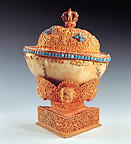
Item: Miscellaneous
པར་ཤིང་སྣང་བརྙན། སྣ་ཚོགས།
版画 (多种)
(item no. 101504)
| Origin Location | Tibet |
|---|---|
| Date Range | 1800 - 1899 |
| Lineages | Buddhist |
| Collection | Private |
| Catalogue # | Tibet Museum, Lhasa |
Notes about the Central Figure
Classification: Object/Concept
Skullcup (Sanskrit: kapala): a human cranium used for fearsome tantric rituals in Northern Buddhism.
Jeff Watt 6-2005
The skullcup is made from a human skull and used in the Tantric rituals of wrathful deities. The empty skull represents impermanence along with the Buddhist philosophical concept of emptiness (Sanskrit: shunyata). The Tibetan inscription on the label of the storage container records that the cup was made from the cranium of Tenpai Wangchug (also known as Kedrup Chenpo), a great scholar and adept. It was offered to a Dalai Lama by Chungtsang Tulku of Dragyab Monastery in Chamdo, Eastern Tibet. (Text courtesy of the Rubin Museum of Art).
Exhibition: Tibet, Treasures from the Roof of the World
Thematic Sets
Sculpture: Miscellaneous
Ritual Object: Skullcup Main Page
Copyright © 2025
Himalayan Art Resources Inc.
Images Provided Courtesy of Private Collections
